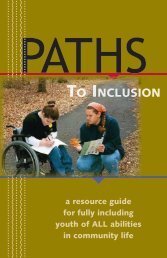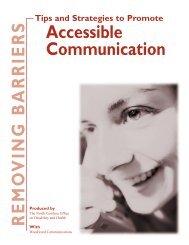Active Citizens 101 - National Service Inclusion Project
Active Citizens 101 - National Service Inclusion Project
Active Citizens 101 - National Service Inclusion Project
Create successful ePaper yourself
Turn your PDF publications into a flip-book with our unique Google optimized e-Paper software.
Procedures, cont.<br />
11. Review the civil rights laws<br />
studied, divide participants<br />
into groups, and review the instructions<br />
for the activity on<br />
Handout 4.1 (c) Civic Rights<br />
Laws “Can They Do This”<br />
Depending on your group,<br />
you can ask a participant from<br />
each group to summarize the<br />
problem and give the two-sentence<br />
decision, or you can do<br />
a “jig-saw.” To do this, have participants in<br />
each group count off from one to the total<br />
number of participants in the group. Then<br />
have all the “ones” form a group, the “twos,”<br />
etc. Since participants in the new groups will<br />
have worked on different situations, each<br />
can now teach the group about their particular<br />
problem situation and explain how a civil<br />
rights law does or doesn't apply to the case.<br />
When you use the jig-saw, all participants<br />
hear all situations and the applicable laws,<br />
and all have an opportunity to make a short<br />
oral presentation.<br />
Facilitator Answers:<br />
(1) 1. “Equal pay for equal work for men and<br />
women.” Ann and Joe do essentially the<br />
same work even though their titles are different.<br />
The Equal Pay Act of 1963 requires<br />
equal pay when the work is equal even if different<br />
job titles are given.<br />
(2) 9. “No discrimination by sex in schools<br />
(sports, teachers, college loans, etc.).” Since<br />
these laws are summarized rather generally<br />
for students, choosing 4. “No discrimination<br />
by race, color, religion, sex or national origin<br />
by state and local governments,<br />
public schools, and<br />
universities” is also logical. Title<br />
IX of the Education Act<br />
Amendments of 1972 requires<br />
school athletic programs to<br />
accommodate both sexes, although<br />
spending equal money<br />
on men's and women's sports<br />
is not required.<br />
(3) 6. “No discrimination by race, color, religion<br />
or national origin in selling or renting<br />
most houses and apartments.” It is true that<br />
landlords and sellers can require that a person<br />
have sufficient income to pay and good<br />
references. However, under the Fair Housing<br />
Act, landlords may not discriminate<br />
against people in the categories listed (“protected<br />
categories”) if a housing unit is over<br />
four units. The 1968 Act was amended in<br />
1988 to include families with children as well<br />
as the disabled in the protected categories.<br />
Restricting housing to a certain group is only<br />
allowed for the elderly.<br />
(4) This example does not violate any of the<br />
civil rights laws; it is possible to specify an<br />
age of maturity, and 21 is an accepted<br />
measure.<br />
(5) 4. “No discrimination by race, color, religion,<br />
sex or national origin by state and local<br />
governments, public schools, and universities.”<br />
This example is modeled on an actual<br />
Supreme Court case, Keyes v. Denver<br />
School District # 1, 1973.<br />
DRAFT<br />
33






